

Welcome to Our Yard
Our home is located in Ocala, Florida, where we have spent the past nine years trying to figure out what grows best and with the least care. We formerly lived near Chicago, Illinois, where we had great success growing trees, vegetables, and flowers. This southern climate was a challenge and a new experience. For numerous articles about a Texas yard and gardens, see Garden Bits
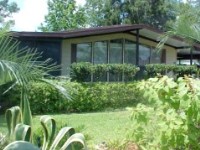
Trees
Several small young trees were growing in our yard when we purchased the property. A sycamore, Bradford pear, and sweetgum were removed from the back yard. The invasive Chinese tallows and camphor trees have been either brought under control or removed. Several evergreen arborvitaes have also been removed, including the ones on each side of the driveway that grew too large and created a traffic hazard.
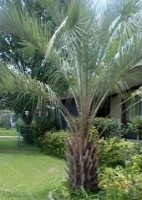 |
Pindo palm (Butia capitata) on left is located in front of our home. We had it planted in 1993. We have a smaller pindo in another island. Washington palm (Washingtonia robusta), pictured at right, grows large in size, but our palm is still quite short and compact. It is located in the large island with two small sabal palms. Several anoles and a small black snake have been seen around its ragged trunk. The leaf bases are beginning to peel off at the bottom of the tree. | 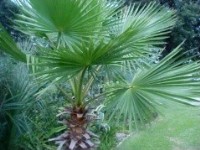 |
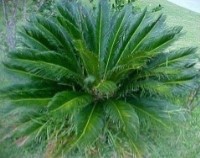 |
Sago Palm (Cycus circinalis) is a stout slow-growing cycad that was a tiny plant several years ago. After removing a shrub overshadowing it, the tree has improved its alignment and grown rather wide. Heavy frost will sometimes damage part of the leaves. |
| Chinese tallow (Sapium sebiferum) is a very invasive deciduous alien tree, also called "popcorn tree." In the fall we trim all three down to a bare trunk. The following spring, new branches form at the top, making a compact tree that produces very few troublesome seeds. This has been done for several years and the trees still provide adequate shade during the summer. | 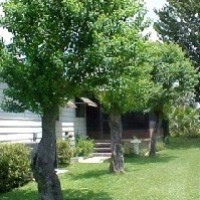 |
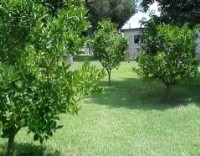 |
We have three orange trees in our back yard, each a different variety. We get a profusion of blossoms that have a delicious smell, but many blossoms are lost before they develop. The trees are beginning to produce more oranges every year. |
| The loquat (Eriobotrya japonica) , in the Rosaceae family, is an evergreen with ten-inch leaves, delicious fruits, and reaches a height of about twenty feet. It is considered one of Florida's best trees. We have azaleas growing at its base. | 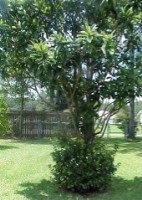 |
Shrubs
Most of our shrubs are pruned when dormant for better bloom and shape. They are maintained as "mid-story" plants, providing a layered look and adding interest.
| Crape myrtle (Lagerstroemia indica) is a deciduous shrub from China that blooms profusely almost all summer. It develops smooth mottled bark when it gets older. It is sometimes called the "Lilac of the South." They have no fragrance, but their blossoms last much longer. | 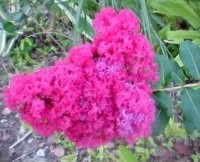 |
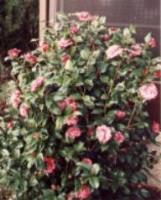 |
Camellia (Camellia japonica), evergreen, blooms in midwinter with large rose-red blossoms with slight streaks of white. We also have a smaller shrub that has even larger blooms. Their foliage is a deep, lustrous evergreen. |
| Shrimp plant (Beloperone guttata) is a herbaceous perennial that attracts hummingbirds and butterflies. The blossom spikes have showy, brownish bracts that resemble boiled shrimps. The small white structures are the actual flowers. Heavy frost could damage the plant down to the soil line, but the plants usually recover. | 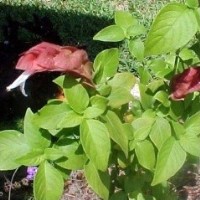 |
Flowers
The main purpose of the flowers in our yard is to attract butterflies and humming birds. We prefer the native plants that are easier to maintain and require less water, but also use other flowers. Tropical sage (Salvia coccinea), of the mint family, blooms all year and attracts hummingbirds and butterflies.
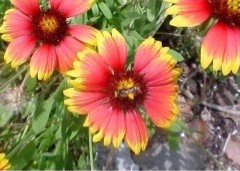 |
Blanket flower (Gaillardia pulchella), a native wildflower, reseeds itself quite well. The center flower has a bee with its legs heavily coated with pollen. |
Spiders
Spiders are in the order Araneida, in the class Arachnida, phylum Arthropoda, which includes about 36,000 species in the 11 orders. These are a few of the many we found in our yard. Orchard spider (Lecauge mabelae), is a typical orb weaver belonging to the family Araneidae. They have very bright patches of red on their underbodies. They make webs, usually in layers with several different sized members of the same species.
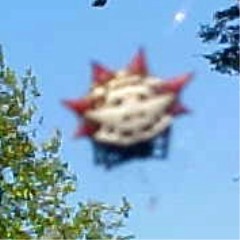 |
Thorny orb-weaver spider (Gasteracantha cancriformis) is one of two common orb-weavers that have bodies decorated with bizarre thorns. The other (Micrathena gracilis) is triangular and yellow. I often watched this one feed on small gnats that flew into its web. The tiny (3/8 inch) spider hangs upside down in the center of its web, drops down on a line, grabs the gnat, and zooms back up to the center. It makes several long white lines radiating out from the center of its daily constructed web. |
| Garbage-line spider (Cyclosa conica? sp?) in the orange tree where I first noticed the thorny spider. The spider itself is somewhere in the middle of the vertical white stripe, called a stabilmentum, containing remains of other insects and debris. | 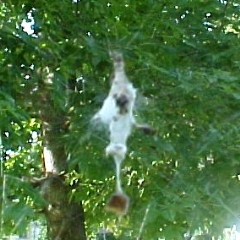 |
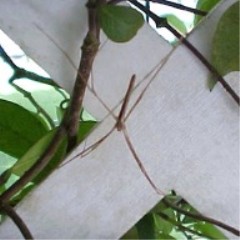 |
Net Casting Spider (Deinopidae Dienopis), one of four genera, on the carport trellis amongst the tangle of vines. Also called an Ogre-faced spider (due to its large eyes) or a Stick spider. It captures prey by weaving a sort of net and tosses it out with its legs. It does its hunting at night. |
Reptiles
Four groups of reptiles occur in our area in Florida: alligators, turtles (including tortoises), lizards, and snakes. There have been no sightings of gators in our yard since we are located over one mile from a waterway. Before the woods located behind us was developed for housing, we were visted by a gopher tortoise and a few box turtles, including a tiny hatchling found in one of our gardens.
We have also had several sightings of the unusual Worm Lizard (Rhineura floridana), called an amphisbaenian, Greek, meaning "one that goes in both directions." Another resident is the Southern Black Racer (Coluber constrictor priapus) which does not kill its prey by constriction; it swallows its prey alive.
| Green Anole (Anolis carolinensis). We have many anoles in our yard since we try to not use pesticides that may harm them. Of course, this gives them more insects for food, but they are very interesting and entertaining | 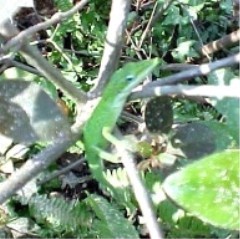 | |
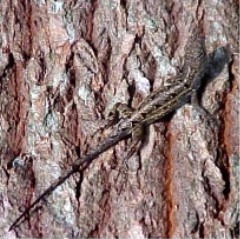 |
Cuban Brown Anole (Anolis sagrei sagrei). It is presumed that
this West Indies anole was introduced to Florida by landscapers in the
early 1970s through tropical plants containing egg of the
anole. Occasionally we see a blue-tailed skink (pictured on right). |
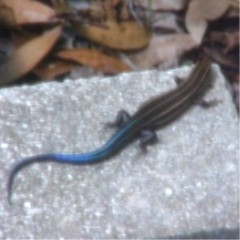 |